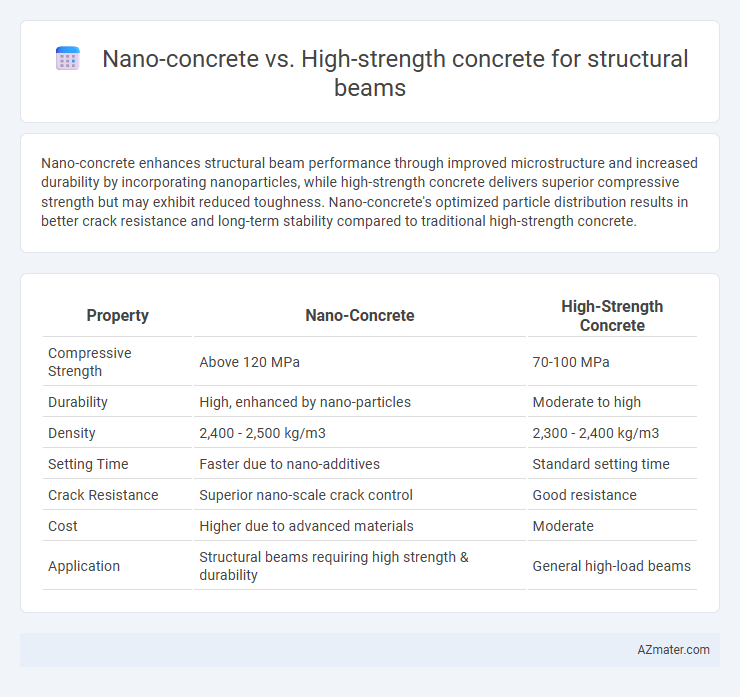Nano-concrete enhances structural beam performance through improved microstructure and increased durability by incorporating nanoparticles, while high-strength concrete delivers superior compressive strength but may exhibit reduced toughness. Nano-concrete's optimized particle distribution results in better crack resistance and long-term stability compared to traditional high-strength concrete.
Table of Comparison
| Property | Nano-Concrete | High-Strength Concrete |
|---|---|---|
| Compressive Strength | Above 120 MPa | 70-100 MPa |
| Durability | High, enhanced by nano-particles | Moderate to high |
| Density | 2,400 - 2,500 kg/m3 | 2,300 - 2,400 kg/m3 |
| Setting Time | Faster due to nano-additives | Standard setting time |
| Crack Resistance | Superior nano-scale crack control | Good resistance |
| Cost | Higher due to advanced materials | Moderate |
| Application | Structural beams requiring high strength & durability | General high-load beams |
Introduction to Nano-Concrete and High-Strength Concrete
Nano-concrete incorporates nanoparticles such as nano-silica to enhance microstructure, resulting in superior mechanical properties and durability compared to conventional mixes. High-strength concrete (HSC) typically achieves compressive strengths above 40 MPa through optimized cement content, admixtures, and curing methods, making it suitable for heavily loaded structural beams. Advanced nano-concrete technology further refines particle packing and hydration processes, offering improved crack resistance and load-bearing capacity essential for structural beam applications.
Chemical Composition and Material Properties
Nano-concrete incorporates nano-sized particles such as nano-silica and nano-titanium dioxide, enhancing hydration and refining the microstructure, leading to superior chemical resistance and increased mechanical strength compared to conventional high-strength concrete. High-strength concrete typically consists of low water-to-cement ratios and supplementary cementitious materials like silica fume, resulting in higher compressive strengths but less modification at the nano-scale. Material properties of nano-concrete exhibit improved durability, reduced porosity, and enhanced tensile strength, making it ideal for structural beams requiring long-term performance and resistance to chemical degradation.
Advances in Mixture Design and Nanotechnology
Nano-concrete incorporates nanoscale materials such as nano-silica and carbon nanotubes to enhance the microstructure, resulting in improved mechanical properties and durability compared to traditional high-strength concrete. Advances in mixture design focus on optimizing particle packing density and dispersion of nanoparticles to achieve superior compressive strength, reduced porosity, and enhanced bonding within structural beams. Nanotechnology enables controlled hydration processes and crack propagation resistance, significantly extending the service life of beams in high-stress structural applications.
Mechanical Strength Comparison
Nano-concrete exhibits significantly enhanced mechanical strength compared to high-strength concrete, with improvements in compressive strength reaching up to 30% due to the incorporation of nanoparticles like nano-silica, which refine the microstructure and reduce porosity. High-strength concrete typically achieves compressive strengths of 70-100 MPa, while nano-concrete can exceed these values by optimizing particle packing density and hydration processes. The improved tensile and flexural strength of nano-concrete also results in superior crack resistance and durability, making it highly suitable for structural beam applications requiring enhanced load-bearing capacity.
Structural Performance in Beams
Nano-concrete exhibits superior structural performance in beams due to its enhanced microstructure that improves bond strength, durability, and crack resistance compared to traditional high-strength concrete. The inclusion of nanoparticles such as nanosilica increases compressive strength and reduces porosity, resulting in better load-bearing capacity and flexural performance. High-strength concrete provides significant strength gains but may experience brittleness and reduced toughness, making nano-concrete a more effective solution for optimized beam durability and resilience under dynamic loads.
Durability and Long-Term Service Life
Nano-concrete exhibits enhanced durability compared to high-strength concrete by incorporating nano-sized particles that improve microstructure, reducing porosity and crack propagation in structural beams. High-strength concrete offers superior load-bearing capacity but may be more susceptible to microcracking under long-term stress and environmental exposure. The advanced nanomaterials in nano-concrete promote longer service life through improved resistance to chemical attacks, freeze-thaw cycles, and corrosion of reinforcement, ensuring sustained structural integrity.
Workability and Construction Considerations
Nano-concrete enhances workability by improving particle packing density and reducing water demand, resulting in a more fluid mix without compromising strength. High-strength concrete, while offering superior load-bearing capacity, often requires precise mix design and careful curing to prevent brittleness and cracking issues during construction. Construction considerations for nano-concrete include specialized handling and dispersion techniques to ensure uniform nanoparticle distribution, whereas high-strength concrete demands stringent quality control for aggregate grading and admixture compatibility to maintain workability and durability.
Cost Efficiency and Economic Impact
Nano-concrete incorporates nanoparticles to enhance durability and strength while reducing material usage, leading to lower lifecycle costs compared to traditional high-strength concrete. High-strength concrete, though offering excellent load-bearing capacity, often involves higher initial material and curing costs, impacting overall project budgets. The economic impact favors nano-concrete for long-term savings in maintenance and repair, making it a cost-efficient choice for structural beams in infrastructure projects.
Environmental Sustainability Factors
Nano-concrete enhances structural beams by incorporating nanoparticles that improve durability and reduce material consumption, thereby lowering the carbon footprint compared to traditional high-strength concrete. High-strength concrete offers excellent load-bearing capacity but often requires higher cement content, leading to increased CO2 emissions during production. Selecting nano-concrete for beams optimizes environmental sustainability through resource efficiency and extended service life, contributing to reduced environmental impact in construction projects.
Future Trends and Applications in Structural Engineering
Nano-concrete incorporates nanoparticles like nano-silica to enhance mechanical properties and durability, promoting ultra-high performance in structural beams with improved crack resistance and longevity. High-strength concrete, characterized by compressive strengths typically above 6,000 psi, remains prevalent for load-bearing beams but faces limitations in brittleness and long-term durability under aggressive environments. Future trends emphasize integrating nano-concrete technologies with smart materials and 3D printing for adaptive, resilient structural beams in sustainable infrastructure and seismic zones.

Infographic: Nano-concrete vs High-strength concrete for Structural beam
 azmater.com
azmater.com